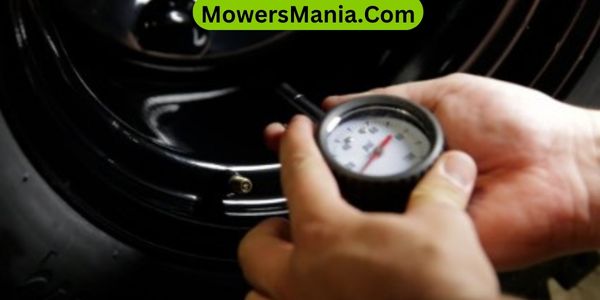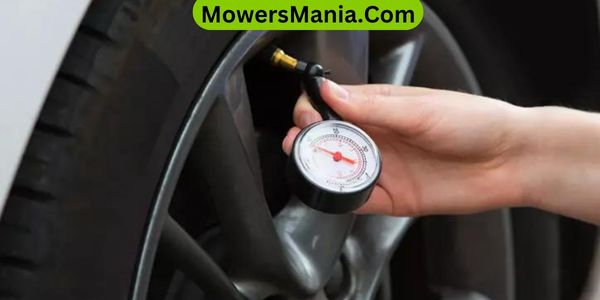Hey, did you know that improper tire pressure on your lawn mower can affect its performance?
Checking the tire pressure is crucial for maintaining even cuts and preventing unnecessary wear and tear.

Let’s walk through the simple steps to ensure your lawn mower’s tires are properly inflated.
Importance of Tire Pressure
To maintain optimal performance and safety, it’s crucial to regularly check the tire pressure on your lawn mower. Proper tire pressure ensures that your lawn mower operates efficiently and reduces the risk of accidents.
When the tire pressure is too low, the tires can become misshapen, affecting the mower’s stability and maneuverability. On the other hand, overinflated tires can lead to a harsher ride and may cause the tires to wear out prematurely.
Maintaining the correct tire pressure also contributes to fuel efficiency. Underinflated tires increase the rolling resistance, requiring the engine to work harder and consume more fuel.
By keeping the tires properly inflated, you not only ensure a smoother and safer operation but also save on fuel costs and reduce the environmental impact.
Additionally, checking the tire pressure regularly allows you to identify any potential leaks or damage to the tires. Catching and addressing these issues early can prevent more significant problems in the future, ultimately saving you time and money.
Therefore, taking a few minutes to check and maintain the tire pressure on your lawn mower can significantly impact its performance and longevity.
Necessary Tools and Equipment
You will need a tire pressure gauge to accurately measure the tire pressure on your lawn mower. In addition to the tire pressure gauge, having a few other tools and equipment handy can make the task easier.
Here’s a list of necessary tools and equipment for checking the tire pressure on your lawn mower:
| Tools and Equipment | Description | Purpose |
|---|---|---|
| Tire Pressure Gauge | Measuring tool | Accurately measure tire pressure |
| Air Compressor | Portable compressor | Inflate tires to the correct pressure |
| Valve Core Tool | Small handheld tool | Remove and install valve cores |
| Pliers | Hand tool | Aid in removing valve caps |
Having these tools readily available will ensure that you can easily and accurately check the tire pressure on your lawn mower and make any necessary adjustments.
Locating the Tire Valve Stem

Locating the tire valve stem is essential for accurately measuring tire pressure on your lawn mower, ensuring proper maintenance and performance.
To find the tire valve stem on your lawn mower, follow these simple steps:
- Inspect the Tire Sidewall: Look for a small rubber or metal valve sticking out from the tire sidewall. It’s usually located near the rim of the wheel.
- Check Near the Hubcap: In some lawn mowers, the valve stem may be positioned closer to the hubcap. Take a close look around this area to locate it.
- Use a Flashlight: If the valve stem is difficult to spot, especially in low light conditions, using a flashlight can help you locate it more easily.
- Refer to the Manual: If you’re still unable to find the valve stem, consult the lawn mower’s manual for specific guidance on the valve stem’s location.
Checking the Current Tire Pressure
To check the current tire pressure on your lawn mower, start by using a tire gauge to measure the pressure in each tire. Simply press the gauge onto the valve stem to get a reading.
If the pressure is too low or too high, use an air compressor to adjust it accordingly.
Using Tire Gauge
To check the current tire pressure of your lawn mower, utilize a tire gauge.
Follow these steps to accurately measure the tire pressure:
- Unscrew the valve cap on the tire.
- Press the tire gauge onto the valve stem firmly to get a reading.
- Check the gauge to see the current tire pressure reading.
- If the pressure is below or above the recommended level, use an air compressor to inflate or deflate the tire accordingly.
Adjusting if Necessary
Once you have checked the current tire pressure of your lawn mower, if necessary, adjust the pressure using an air compressor for optimal performance. Start by removing the valve cap and attaching the air compressor hose to the valve.
Add air in short bursts, checking the pressure with the tire gauge after each burst. Stop adding air when the pressure reaches the recommended level. If you accidentally overinflate the tire, press the small pin on the tire valve to release some air.
Once the pressure is adjusted, replace the valve cap securely. Repeat the same process for all the tires, ensuring they’re properly inflated for even and efficient mowing.
Proper tire pressure not only ensures better traction and maneuverability but also extends the life of your lawn mower tires.
Adjusting the Tire Pressure
Use a tire gauge to measure the pressure in each tire, and adjust as needed to match the manufacturer’s recommended pressure.
Here’s how to adjust the tire pressure on your lawn mower:
Following these steps will help ensure that your lawn mower’s tires are at the optimal pressure for efficient and effective operation.
Regular Maintenance Tips

Now that you know how to adjust the tire pressure on your lawn mower, it’s important to understand the significance of regular maintenance.
Checking the tire pressure is just one part of the overall maintenance routine.
You should also consider the frequency of these checks to ensure your lawn mower stays in top condition.
Tire Pressure Importance
To ensure optimal performance and longevity of your lawn mower tires, regularly monitor and adjust the tire pressure. Proper tire pressure is crucial for a smooth and even cut, as well as overall stability and maneuverability of your mower.
Here are some reasons why maintaining the correct tire pressure is important:
- Even Cutting: Correct tire pressure ensures that all tires have proper contact with the ground, resulting in an even and well-manicured lawn.
- Stability: Maintaining the right tire pressure enhances the stability of your lawn mower, reducing the risk of tipping or losing control on uneven terrain.
- Tire Longevity: Properly inflated tires are less prone to wear and tear, ultimately extending the lifespan of your lawn mower’s tires.
- Fuel Efficiency: Maintaining the recommended tire pressure can contribute to improved fuel efficiency, saving you money in the long run.
Checking Tire Pressure
Make sure to regularly utilize a pressure gauge to check the tire pressure on your lawn mower. Proper tire pressure is crucial for maintaining the performance and maneuverability of your lawn mower. Check the recommended tire pressure in the owner’s manual or on the sidewall of the tire.
It’s essential to inspect the tire pressure before each mowing session, especially if the mower has been sitting idle for an extended period.
Use a pressure gauge to measure the current tire pressure, and if it’s below the recommended level, inflate the tires to the appropriate pressure using a compressor.
Overinflated tires can be just as problematic as underinflated ones, so it’s important to follow the manufacturer’s guidelines for optimal tire pressure.
Regular tire pressure checks will ensure a smooth and efficient mowing experience.
Maintenance Frequency
Regularly checking and maintaining your lawn mower will ensure its optimal performance and longevity.
Here are some regular maintenance tips to keep your lawn mower in top shape:
- Clean or replace the air filter every season to ensure proper airflow and prevent debris from entering the engine.
- Change the oil at least once a year or after every 50 hours of use to keep the engine running smoothly.
- Sharpen or replace the mower blades as needed to ensure a clean cut and prevent tearing of the grass.
- Inspect and replace spark plugs if necessary to maintain efficient fuel combustion and smooth engine operation.
Following these regular maintenance tips will help keep your lawn mower in excellent condition and ready for the next mowing season.
Frequently Asked Questions [FAQs]
What Is the Recommended Tire Pressure for a Lawn Mower?
You should check the owner’s manual for the recommended tire pressure for your lawn mower. It’s important to maintain the correct tire pressure to ensure proper traction and prevent uneven wear on the tires.
Can I Use a Regular Tire Pressure Gauge to Check the Tire Pressure on My Lawn Mower?
Yes, you can use a regular tire pressure gauge to check the tire pressure on your lawn mower. It’s a quick and simple way to ensure that your tires are properly inflated for optimal performance.
How Often Should I Check the Tire Pressure on My Lawn Mower?
You should check the tire pressure on your lawn mower at least once a month. It’s important to keep the tires properly inflated for better traction and to prevent damage. Regular checks will help maintain optimal performance.
What Should I Do if the Tire Pressure on My Lawn Mower Is Too Low?
If the tire pressure on your lawn mower is too low, use a tire gauge to check the pressure. Then, inflate the tires to the recommended PSI using a portable air compressor. Regularly maintaining proper tire pressure ensures smooth mowing.
Are There Any Signs or Symptoms That Indicate My Lawn Mower’s Tire Pressure May Be Incorrect?
If your lawn mower’s tire pressure is incorrect, you may notice signs like uneven tire wear, difficulty steering, or a bumpy ride. Checking the tire pressure regularly can help prevent these issues.
Conclusion
Now that you know how to check the tire pressure on your lawn mower, you can ensure that it’s always in top condition for mowing.
Regular maintenance and checking the tire pressure will help improve the performance and longevity of your lawn mower.
It only takes a few minutes to check and adjust the tire pressure, so make it a regular part of your lawn mower care routine.



